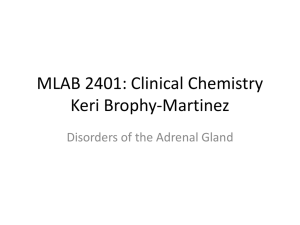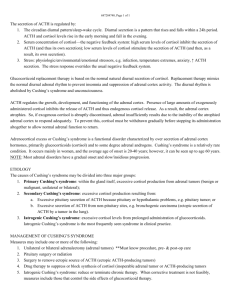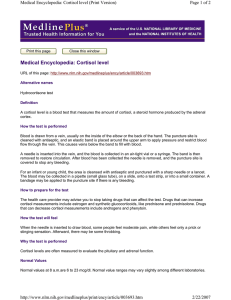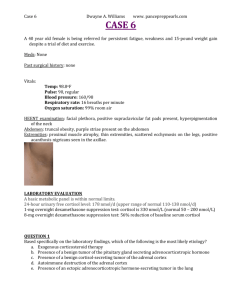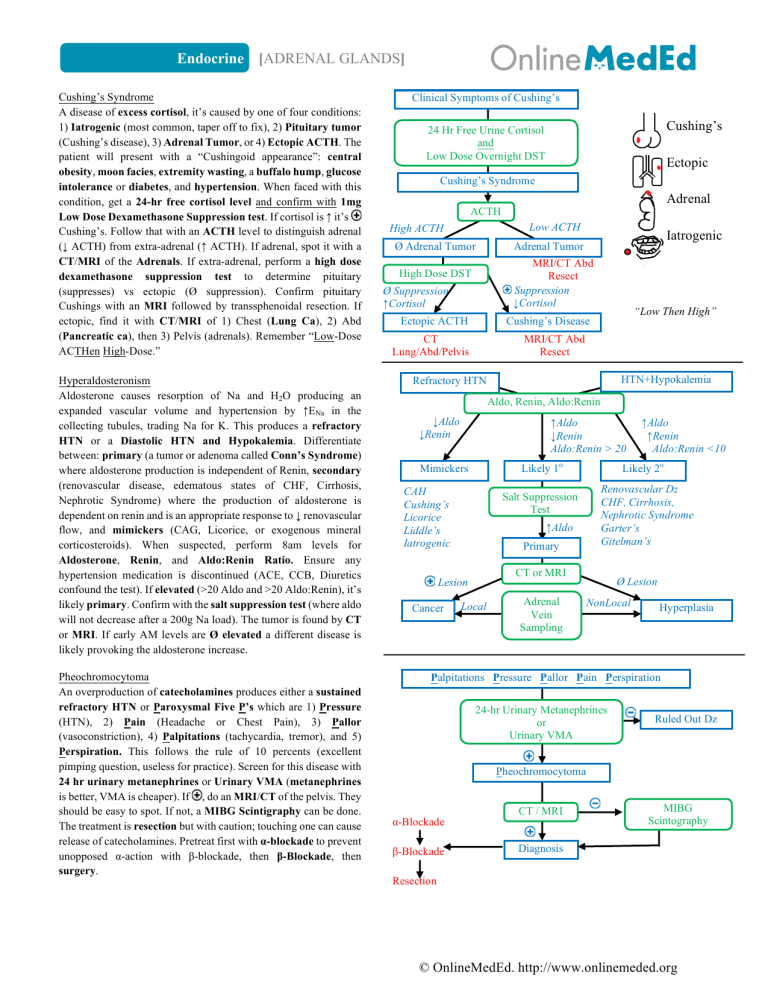
Endocrine [ADRENAL GLANDS] Cushing’s Syndrome A disease of excess cortisol, it’s caused by one of four conditions: 1) Iatrogenic (most common, taper off to fix), 2) Pituitary tumor (Cushing’s disease), 3) Adrenal Tumor, or 4) Ectopic ACTH. The patient will present with a “Cushingoid appearance”: central obesity, moon facies, extremity wasting, a buffalo hump, glucose intolerance or diabetes, and hypertension. When faced with this condition, get a 24-hr free cortisol level and confirm with 1mg Low Dose Dexamethasone Suppression test. If cortisol is ↑ it’s Cushing’s. Follow that with an ACTH level to distinguish adrenal (↓ ACTH) from extra-adrenal (↑ ACTH). If adrenal, spot it with a CT/MRI of the Adrenals. If extra-adrenal, perform a high dose dexamethasone suppression test to determine pituitary (suppresses) vs ectopic (Ø suppression). Confirm pituitary Cushings with an MRI followed by transsphenoidal resection. If ectopic, find it with CT/MRI of 1) Chest (Lung Ca), 2) Abd (Pancreatic ca), then 3) Pelvis (adrenals). Remember “Low-Dose ACTHen High-Dose.” Hyperaldosteronism Aldosterone causes resorption of Na and H2O producing an expanded vascular volume and hypertension by ↑ENa in the collecting tubules, trading Na for K. This produces a refractory HTN or a Diastolic HTN and Hypokalemia. Differentiate between: primary (a tumor or adenoma called Conn’s Syndrome) where aldosterone production is independent of Renin, secondary (renovascular disease, edematous states of CHF, Cirrhosis, Nephrotic Syndrome) where the production of aldosterone is dependent on renin and is an appropriate response to ↓ renovascular flow, and mimickers (CAG, Licorice, or exogenous mineral corticosteroids). When suspected, perform 8am levels for Aldosterone, Renin, and Aldo:Renin Ratio. Ensure any hypertension medication is discontinued (ACE, CCB, Diuretics confound the test). If elevated (>20 Aldo and >20 Aldo:Renin), it’s likely primary. Confirm with the salt suppression test (where aldo will not decrease after a 200g Na load). The tumor is found by CT or MRI. If early AM levels are Ø elevated a different disease is likely provoking the aldosterone increase. Pheochromocytoma An overproduction of catecholamines produces either a sustained refractory HTN or Paroxysmal Five P’s which are 1) Pressure (HTN), 2) Pain (Headache or Chest Pain), 3) Pallor (vasoconstriction), 4) Palpitations (tachycardia, tremor), and 5) Perspiration. This follows the rule of 10 percents (excellent pimping question, useless for practice). Screen for this disease with 24 hr urinary metanephrines or Urinary VMA (metanephrines is better, VMA is cheaper). If , do an MRI/CT of the pelvis. They should be easy to spot. If not, a MIBG Scintigraphy can be done. The treatment is resection but with caution; touching one can cause release of catecholamines. Pretreat first with α-blockade to prevent unopposed α-action with β-blockade, then β-Blockade, then surgery. Clinical Symptoms of Cushing’s Cushing’s 24 Hr Free Urine Cortisol and Low Dose Overnight DST Ectopic Cushing’s Syndrome Adrenal ACTH Low ACTH High ACTH Ø Adrenal Tumor Iatrogenic Adrenal Tumor MRI/CT Abd Resect Suppression ↓Cortisol High Dose DST Ø Suppression ↑Cortisol Ectopic ACTH “Low Then High” Cushing’s Disease CT Lung/Abd/Pelvis MRI/CT Abd Resect HTN+Hypokalemia Refractory HTN Aldo, Renin, Aldo:Renin ↓Aldo ↓Renin ↑Aldo ↓Renin Aldo:Renin > 20 Likely 1o Mimickers CAH Cushing’s Licorice Liddle’s Iatrogenic Cancer Likely 2o Renovascular Dz CHF, Cirrhosis, Nephrotic Syndrome Garter’s Gitelman’s Salt Suppression Test ↑Aldo Primary CT or MRI Lesion Local Adrenal Vein Sampling ↑Aldo ↑Renin Aldo:Renin <10 Ø Lesion NonLocal Hyperplasia Palpitations Pressure Pallor Pain Perspiration 24-hr Urinary Metanephrines or Urinary VMA Ruled Out Dz Pheochromocytoma α-Blockade β-Blockade CT / MRI MIBG Scintography Diagnosis Resection © OnlineMedEd. http://www.onlinemeded.org Endocrine [ADRENAL GLANDS] Adrenal Incidentalomas These are asymptomatic adrenal masses found on CT scan for something else - an “incidental finding.” It’s important to rule out functioning adenomas (pheo, aldo, cortisol, androgen) from nonfunctioning adenomas. All above findings must be done to rule out Cushing’s (DST), Pheo (24-hr urine metanephrines) and Aldo (plasma renin and Aldo). A direct needle biopsy should NOT be done until pheo is ruled out. It’s ok to watch and wait if <4cm, but intervene with treatment if >4cm or there’s an increase in size over time. Adrenal Insufficiency The loss of adrenal function may be from a variety of etiologies, and may be sudden/acute with multiple presentations. The most common cause in the US is autoimmune adrenalitis; it’s TB worldwide. In the setting of sepsis there may be bilateral adrenal destruction from hemorrhage (Waterhouse-Friderichsen). Weird deposition disease can also compromise the adrenals (amyloid, sarcoid, and hemochromatosis). In primary failure (loss of cortisol, maintenance of ACTH) the symptoms will be hypotension, fatigue, N/V of cortisol loss, as well as the hyperpigmentation and hyperkalemia. Hyperpigmentation is a result of ACTH production trying to increase cortisol while hyperkalemia is from deficient aldosterone. In secondary failure, no ACTH is produced so hyperpigmentation is absent. Because aldosterone production is intact there’s also no hyperkalemia. It’s key to make sure it’s not a primary deficiency so perform a cosyntropin test (exogenous ACTH administration). Establish a baseline cortisol in the morning (<3ug = Dz, >18ug = ruled out). Give the ACTH then reassess in 60 minutes to determine if there’s any change in cortisol. (3, 3, 3 = Ø ACTH problem = 10 deficiency) vs (3, 3, 20 = ACTH problem, 2o deficiency). Treat this by giving the steroids they don’t have. Prednisone for all types and fludrocortisone for primary only (it’s a synthetic aldo that has its function retained through the RAAS in secondary). Dz Cushing’s r/o… Cushing’s Pheo Conn’s Hypotension + Hyperkalemia + N/V >18 Ruled Out Dz 3am Cortisol <3 Adrenal Insufficiency Cosyntropin Test Ø ∆ Cortisol ↑ Cortisol after 60 minutes 1o Failure 2o Failure Prednisone Only Prednisone AND Fludrocortisone Path/Etiology Iatrogenic Pituitary Tumor Adrenal Tumor Ectopic Tumor 1o Dz = Tumor 2o Dz = Systemic Mimickers Presentation Obesity, Diabetes Moon Facies, Buffalo Hump Pheo Adrenal Tumor Paroxysmal Pain Pressure Palpitations Pallor Perspiration Adrenal Insufficiency Autoimmune Infection Hemorrhage Deposition Disease Pituitary Failure Hypotension Fatigue Anorexia Nausea/Vomiting Hyperpigmentation Hyperaldo (Conn’s) With Dexamethasone Suppression test 24-Hr Urine Aldo/Renin Hypertension and HypoK OR Refractory HTN Cortex - Glomerulosa “Salt” Aldosterone Fasiculata “Sugar” Cortisol Reticularis “Sex” Testosterone Medulla à Catecholamines Diagnostic Low Dose Dexa Suppression ACTH levels High Dose Dexa Suppression CT/MRI Abd/Pelvis/Thorax Aldo, Renin, Aldo:Renin Salt Suppression CT/MRI MIBG Scintillography 24-hr Urinary Metanephrine or VMA Urine CT/MRI Cortisol Level @ 3am Cosyntropin Test CT/MRI Tx Stop Steroids or Cut out Tumor Cut out Tumor Fix Systemic Dz α-Blockade β-Blockade Adrenalectomy 1o = Prednisone (cortisol) and Fludrocortisone 2o = Prednisone Only © OnlineMedEd. http://www.onlinemeded.org


